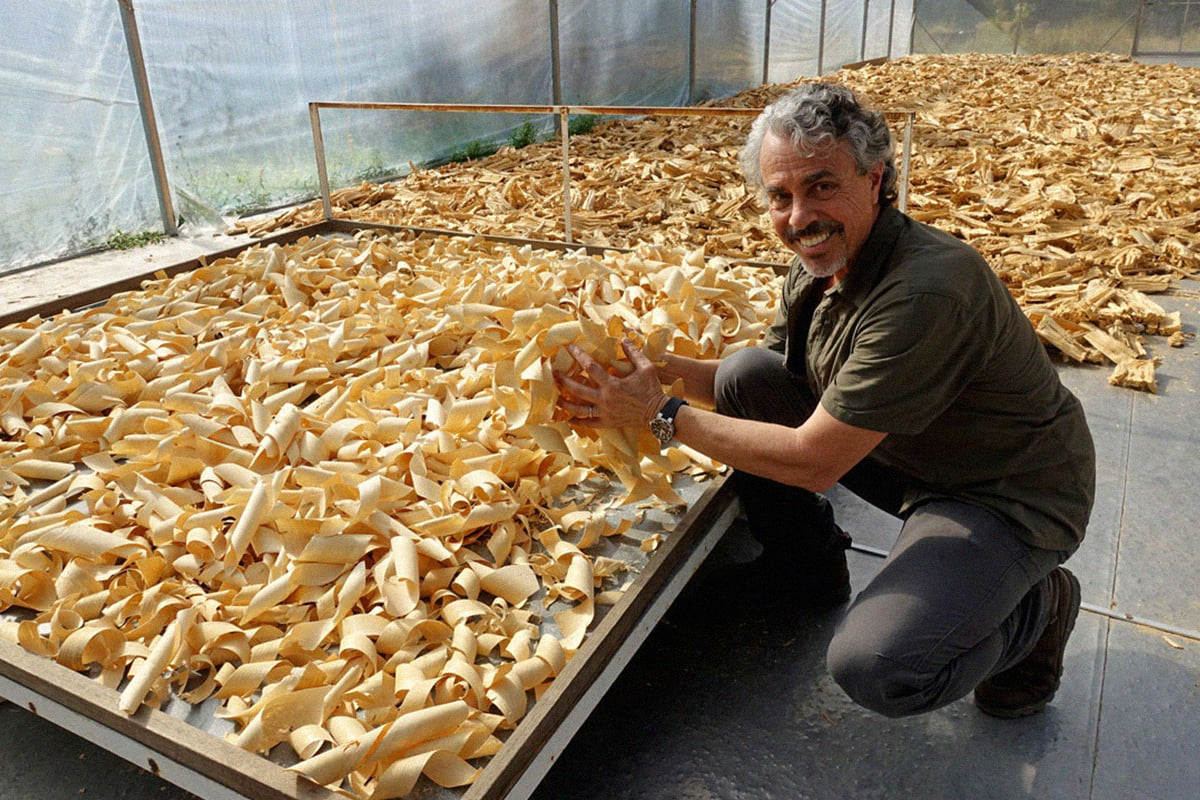In February 2019, I traveled to Malaysia in Southeast Asia on behalf of ongoing work with Purity Products® to investigate the herb Tongkat Ali and to observe the chain of trade of this plant from forest to finished extract. This was not my first time doing so. I have previously been to Malaysia half a dozen times to study this herb, including a project with ABC’s Nightline. This time, my purpose was to see and chronicle the work of LJACK™, a Malaysian supplier of Tongkat Ali extract.
In the work that Purity Products® and I conduct together, I try to get into the field as much as possible, to personally see everything relevant to the trade of herbs. While many companies just pick up the phone and place an order for extracts and various herbal ingredients, we prefer to go much farther, for greater understanding of herbs from field to finish. This requires a lot of travel to far away places. It also gives us an opportunity to take customers behind the scenes, to share information, photographs, and video. In this way, we hope to bring the world of herbs to you.

Left: On the trail in the Malaysian rain forest. Right: Tongkat Ali before it is chopped.
What Is Tongkat Ali?
Tongkat Ali is a popular folk name for Eurycoma longifolia, a slender, medium-sized tree reaching 30 feet in height. The name Tongkat Ali means “Ali’s walking stick.” Another folk name for the plant is Longjack. In Indonesia, it is known as Pasak Bumi. By any name, Tongkat Ali is native to Malaysia, lower Myanmar (Burma), Thailand, and Indonesia. The plant thrives in shade, and flourishes under the canopy of the rainforest. The root is employed as a traditional remedy for the treatment of malaria, high blood pressure, fevers, fatigue, loss of sexual desire, and impotence.
Nobody knows how long Tongkat Ali has been employed for medicinal purposes, but its documented use dates back to the 1700s. The herb enjoys a long history of traditional application and a growing body of serious science corroborating its uses. In Malaysia, Tongkat Ali is a national treasure, consumed widely to bolster sexual potency, and an ingredient found in more than 300 products, from root chips to herbal syrups, special coffees, infused chocolates, capsules, and popular soft drinks. Southeast Asian men and women equally enjoy Tongkat Ali in a plethora of forms for its sex-enhancing properties. Athletes find Tongkat Ali helps to boost athletic performance, so the herb and its preparations have a good place in Malaysian athletics. Beverages containing Tongkat Ali extract can be found at any gas stop or convenience store, and at roadside stands throughout Malaysia.

Chris Kilham (center) joins the Tongkat Ali team.
Our Tongkat Ali Team
In Malaysia’s capital Kuala Lumpur, I met with LJACK™ founder Chan Chee, his wife Joey, their son Chyan, and Ali, who works with Chan Chee. I had spent time with them previously on a few occasions and had chosen to focus on their work with Tongkat Ali because of their excellent production and manufacturing standards.
From Kuala Lumpur we traveled for several hours to Pahang state to the town of Sri Jaya. There we stopped for food before going to see the basic processing of Tongkat Ali. Sri Jaya receives no non-Asian visitors, so I was somewhat of an entertainment, and wound up making friends with a group of women who get together every morning to talk.
In Sri Jaya, a man named Ronnie runs a Tongkat Ali cleaning and drying business, supplying ready-to-extract Tongkat Ali to LJACK™. After breakfast, we headed to Ronnie’s where shortly after we arrived a pair of Orang Asli pulled in on motorcycles with Tongkat Ali roots tied to their bikes.
The Forest Skills Of The Orang Asli
Orang Asli are the original people of peninsular Malaysia. Today, about 80,000 Orang Asli remain scattered throughout the country. Though many have moved to cities and towns, have married non-aboriginals, and have been assimilated into modern culture, a number of Orang Asli choose to live in settlements called kampongs, and in villages in the forest, leading simpler lives absent of most modern amenities. The Orang Asli are intimately familiar with the Malaysian rainforest. Their history is one of forest life. They know the plants, the animals, the weather, and the various skills required to survive and thrive in the dense jungle. According to Malaysian law, Orang Asli alone have the right to harvest plants and hunt animals as they wish in the forest. Thus, the harvesting of Tongkat Ali is conducted by Orang Asli, and this trade feeds many native families. The two Orang Asli who arrived at Ronnie’s, Dahalan and Moyon, would lead us into the forest to harvest root.

Native Orang Asli show off a freshly harvested Tongkat Ali root.
How is Tongkat Ali Processed?
At Ronnie’s, Tongkat Ali roots are weighed when they arrive. Most herbal trade works on the basis of weight. The heavier the load, the more the money.
After weighing, Tongkat Ali roots are washed, chopped and dried, making them ready for extraction by LJACK™. We observed freshly cleaned root sections getting chopped into smaller pieces, and then put into a large solar dryer. Only when small root pieces are dry, are they ready for shipment to LJACK™ for extraction.

The majestic Malaysian coastline.
Traveling The Forest Roads of Malaysia
Malaysia’s development from a backwater to a modern, thriving nation has come at a terrible environmental cost. Much of the nation’s spectacular 60 million year-old rainforest has been leveled to make way for oil palms for cheap cooking oil. The palm oil business has been part of the country’s “economic miracle,” but has led to environmental destruction on a massive scale. The elephants, tigers, and other wildlife that used to be abundant in Malaysia are now rare and endangered, and the biodiversity of millions of years of natural plant growth has been supplanted by one crop.
We drove past endless palm plantations stretching for as far as the eye can see, until we came to a forest road. In Malaysia there is still healthy old-growth forest, most of it mountainous. Much of this forest is exploited to cut and remove timber for use in decking, floors, and other types of building projects. This cutting is made possible by plowing long access roads deep into virgin forest. We eventually got onto one such logging road and drove for nearly an hour, passing heavy earth-moving equipment, massive bulldozers, and heavy trucks—all part of the timber business.
Eventually, after much time, we stopped at the side of the road. Tongkat Ali harvesting is made possible by such roads, as the Orang Asli need to easily get to Tongkat Ali trees, cut the roots out of the ground, and carry them out of the forest on their shoulders. The trees are relatively abundant and easy to find. Tongkat Ali trees deeper in the forest remain undisturbed, as they are too hard to reach, and the roots are too heavy to carry out for long distances.
Into The Malaysian Rainforest
Hiking into the oldest rainforest in the world proves breathtakingly beautiful, if ultimately challenging. A roasting equatorial sun keeps the temperature hovering in the mid 30s C (high 90s F). Humidity hangs in the air like a wet towel at about 98 percent, so we were drenched with streaming sweat from the onset of our hike.
As we moved into the steep hills of the forest with Dahalan and Moyon in the lead, tripper vines wrapped around our ankles and impeded our progress. We remained vigilant for poisonous snakes, though they’d be almost impossible to spot in the dense undergrowth. The Malaysian rainforest is home to more than 20 species of highly poisonous snakes, including a few that are deadly and aggressive, like the Russell’s viper and the king cobra. We also kept a sharp lookout for toxic giant centipedes, fist-sized black scorpions, fire ants, and sharp bamboo. What seemed useful hand-holds often bore sharp spines and spikes. Many vines and small trees were attached to nothing, so we had to test each one before hanging on and hoisting ourselves up slippery inclines.
The forest is home to rare wild elephants, tigers, and the occasional black leopard, but we were not fortunate enough to catch even a glimpse of those beautiful and elusive animals.

Getting ready to dig out the roots.
Harvesting Tongkat Ali
After a relatively brief hike into the forest, our Orang Asli friends located a good-sized Tongkat Ali tree. Tongkat Ali needs to be at least five years old before it is ready for harvesting, and this one was at least 10 years old. It was a perfect specimen to harvest and would yield a root of around 13 kilos in weight.
To clear some of the foliage from above the Tongkat Ali tree, Moyon worked with a machete, hacking away at nearby brush and overhead branches to clear space for working on the tree. He did this with ease. Next, he cut away the top of the tree from around six feet and up. This would make harvesting the root easier.
Dahalan and Moyon then started to dig around the base of the tree, using an adze, an axe-like tool for cutting and shaping large roots and pieces of wood. After they had dug down a couple of feet, Ali and I helped them to work the root loose from deep in the ground. By moving the tree back and forth we exposed more of the root. Eventually we had loosened the root enough that it could be pulled from the ground. The root broke part way down, leaving some in the deep soil. But overall, we’d probably harvested about 30 pounds of root. Given that the root was a good size and the two had harvested other roots earlier, we hiked our way out of the forest with Dahalan carrying the Tongkat Ali on his shoulders. When we stepped out of the forest and returned to our truck, the root went in the back, which was easier than tying it to a motorcycle. That root would go to Ronnie’s and would undergo the same washing, chopping and drying we had previously seen.

Chris Kilham among the tongkat ali being prepared for the solar dryer.
From Root To LJACK™
A couple of days later, I was in Kuala Lumpur at the extraction facilities and laboratories of LJACK™. The facility is modern, complying with international standards of safety, hygiene, testing, and overall quality and purity. Chan had made arrangements for me to see and photograph the pouring of Tongkat Ali extract into large trays for freeze drying.
It takes 100 kilograms of Tongkat Ali root to make just one kilogram of finished LJACK™ Tongkat Ali extract. The result is an intensely concentrated product. At the factory, we all donned protective sanitary clothing, and went to the area where the extract was being readied for freeze drying. Workers poured thick, concentrated extract into shallow trays, and those trays were put into the freeze dryer. It takes several days for the extract to fully dry. After that, it is ground into a fine powder and then shipped for use in nutritional supplements.
At the LJACK™ lab, one of the scientists showed me how they test Tongkat Ali using HPLC (High Pressure Liquid Chromatography) to determine the concentration of active compounds. The plant contains various classes of bioactive compounds such as quassinoids, β-carboline alkaloids, canthin-6-one alkaloids, triterpene tirucallane type, squalene derivatives and biphenyl neolignan, eurycolactone, laurycolactone, and eurycomalactone, and bioactive steroids, with quassinoids accounting for a major portion of the phytochemicals in the root.
At LJACK™, the lab looks at the quassinoid eurycomanone to establish a baseline for potency.
From stepping into the Malaysian rainforest to watching the final transformation of Tongkat Ali extract into a freeze-dried concentrate, we had followed the entire chain of trade.









